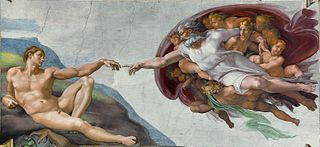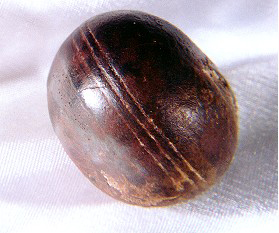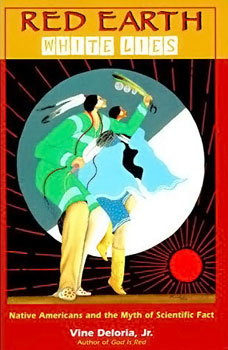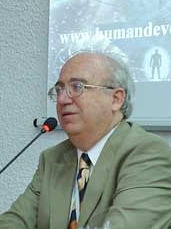
Creationism is the religious belief that nature, and aspects such as the universe, Earth, life, and humans, originated with supernatural acts of divine creation. In its broadest sense, creationism includes a continuum of religious views, which vary in their acceptance or rejection of scientific explanations such as evolution that describe the origin and development of natural phenomena.

Creation science or scientific creationism is a pseudoscientific form of Young Earth creationism which claims to offer scientific arguments for certain literalist and inerrantist interpretations of the Bible. It is often presented without overt faith-based language, but instead relies on reinterpreting scientific results to argue that various myths in the Book of Genesis and other select biblical passages are scientifically valid. The most commonly advanced ideas of creation science include special creation based on the Genesis creation narrative and flood geology based on the Genesis flood narrative. Creationists also claim they can disprove or reexplain a variety of scientific facts, theories and paradigms of geology, cosmology, biological evolution, archaeology, history, and linguistics using creation science. Creation science was foundational to intelligent design.

Young Earth creationism (YEC) is a form of creationism which holds as a central tenet that the Earth and its lifeforms were created by supernatural acts of the Abrahamic God between approximately 6,000 and 10,000 years ago. In its most widespread version, YEC is based on the religious belief in the inerrancy of certain literal interpretations of the Book of Genesis. Its primary adherents are Christians and Jews who believe that God created the Earth in six literal days. This is in contrast with old Earth creationism (OEC), which holds literal interpretations of Genesis that are compatible with the scientifically determined ages of the Earth and universe. It is also in contrast to theistic evolution, which posits that the scientific principles of evolution, the Big Bang, abiogenesis, solar nebular theory, age of the universe, and age of Earth are compatible with a metaphorical interpretation of the Genesis creation account.

Old Earth creationism (OEC) is an umbrella of theological views encompassing certain varieties of creationism which may or can include day-age creationism, gap creationism, progressive creationism, and sometimes theistic evolutionism.

Duane Tolbert Gish was an American biochemist and a prominent member of the creationist movement. A young Earth creationist, Gish was a former vice-president of the Institute for Creation Research (ICR) and the author of numerous publications about creation science.

The Creation Research Society (CRS) is a Christian fundamentalist group that requires of its members belief that the Bible is historically and scientifically true in the original autographs, belief that "original created kinds" of all living things were created during the Creation week described in Genesis, and belief in flood geology.
Carl Edward Baugh is an American young Earth creationist. Baugh has claimed to have discovered human footprints alongside dinosaur footprints near the Paluxy River in Texas. Baugh promoted creationism as the former host of the Creation in the 21st Century TV program on the Trinity Broadcasting Network.
Walter T. Brown is a young Earth creationist, who is the director of his own ministry called the Center for Scientific Creation. The Skeptic's Dictionary considers him to be one of the leaders of the creation science movement. He proposes a specific version of flood geology called the Hydroplate Theory. He is a retired army officer with a degree in mechanical engineering.
Dr. Carl Wieland is an Australian young earth creationist, author and speaker. He was the managing director of Creation Ministries International, a Creationist apologetics ministry. CMI are the distributors of Creation magazine and the Journal of Creation.
John David Morris was an American young earth creationist. He was the son of "the father of creation science", Henry M. Morris, and served as president of the Institute for Creation Research (ICR) from the time of his father's retirement in 1996 until 2020. Morris was a creationist author and spoke at a variety of churches. Many of his presentations discussed the fossil record and its relation to evolution.

Klerksdorp spheres are small objects, often spherical to disc-shaped, that have been collected by miners and rockhounds from 3-billion-year-old pyrophyllite deposits mined by Wonderstone Ltd., near Ottosdal, South Africa. They have been cited by pseudoscientists and reporters in books, popular articles, and many web pages as inexplicable out-of-place artifacts that could only have been manufactured by intelligent beings. Geologists who have studied these objects have concluded that the objects are not manufactured, but are rather the result of natural processes.

Red Earth, White Lies: Native Americans and the Myth of Scientific Fact is a book by Native American author Vine Deloria, originally published in 1995. The book's central theme is to criticize the scientific consensus which has, in his words, created "a largely fictional scenario describing prehistoric North America".
Hindus have found support for, or ideas foreshadowing evolutionary ideas, in scriptures, such as the mytheme of Dashavatara, the incarnations of Vishnu starting with a fish.
Richard Milton is a British journalist and amateur archaeologist. An engineer by training, Milton has written on the topics of popular history, business, and alternative science, and published one novel.

Michael A. Cremo, also known by his devotional name Drutakarmā dāsa, is an American freelance researcher who describes himself as a Vedic creationist and an "alternative archeologist." He argues that humans have lived on Earth for millions of years. Based on artifacts allegedly found in the Eocene auriferous gravels of Table Mountain, California and discussed in his book Forbidden Archeology, Cremo argues for the existence of modern humans on Earth as early as 30 to 40 million years ago. Forbidden Archeology, which he wrote with Richard L. Thompson, has attracted criticism from mainstream scholars, who describe it as pseudoscientific.

Forbidden Archeology: The Hidden History of the Human Race is a 1993 pseudoarchaeological book by Michael A. Cremo and Richard L. Thompson, written in association with the Bhaktivedanta Institute of ISKCON. Cremo states that the book has "over 900 pages of well-documented evidence suggesting that modern man did not evolve from ape man, but instead has co-existed with apes for millions of years!", and that the scientific establishment has suppressed the fossil evidence of extreme human antiquity. Cremo identifies as a "Vedic archeologist", since he believes his findings support the story of humanity described in the Vedas. He says a knowledge filter is the cause of the supposed suppression.
Jeffrey Goodman is an independent American archaeologist with training in geology and archaeology. His early career was in oil exploration.
Robert J. (Bob) Schadewald was an author, researcher, and former president of the National Center for Science Education (NCSE). An internationally recognized expert on pseudoscience, Schadewald penned numerous articles on creationism, perpetual motion, flat earthism, and other pseudoscience for such magazines as Science 80, Technology Illustrated, Smithsonian, and Science Digest.

Richard Leslie Thompson, also known as Sadaputa Dasa, was an American mathematician, author and Gaudiya Vaishnava religious figure. Historian Meera Nanda described him as a driving intellectual force of 'Vedic creationism' as co-author of Forbidden Archeology: The Hidden History of the Human Race (1993), a work that has attracted significant criticism from the scientific community. Thompson also published several books and articles on the relationship between religion and science, Hindu cosmology and astronomy. He was a member of the International Society for Krishna Consciousness and a founding member of the Bhaktivedanta Institute, the branch of ISKCON dedicated to examining the relationship of modern scientific theories to the Vaishnava worldview. In the 'science and religion' community he was known for his articulation of ISKCON's view of science. Danish historian of religion Mikael Rothstein described Thompson as "the single dominating writer on science" in ISKCON whom ISKCON has chosen to "cover the field of science more or less on his own". C. Mackenzie Brown, professor of religion at Trinity University, San Antonio, Texas, described him as "the leading figure" in ISKCON's critique of modern science.








